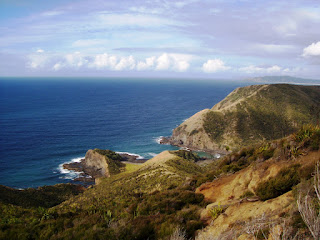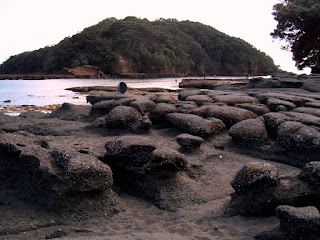
We've found from many mornings of sky-watching, that it's the clouds that make a sunrise particularly beautiful. As it began to get light, clouds formed on the horizon and then the sun coming up lit them on fire!
The sun was definitely a ball of fire as it rose up over the island and reflected on the water. Beautiful morning!

About the moment the sun popped up, the beach was full of early morning walkers and runners. We had gotten a bit cold, sitting on the damp bench in the chilly pre-dawn, so we decided to leave the beach to the others and go to Takapuna, the little downtown near the office where we work. As the morning wore on, it became a bright, warm, beautiful New Zealand day, as you can see by the pretty blue skies below.
 This is such a cute little downtown. Trees planted along the narrow brick streets, pretty lampposts, and a very vibrant downtown. Even in the early hours, the sidewalks were filled with shoppers and people eating outside at the little cafes.
This is such a cute little downtown. Trees planted along the narrow brick streets, pretty lampposts, and a very vibrant downtown. Even in the early hours, the sidewalks were filled with shoppers and people eating outside at the little cafes.


Just a block behind the shops is Takapuna Beach, a very popular and well-known beach. It's about a mile of wide beach and beautiful scenery. Big, beautiful pohutakawa trees and grass line the beach (these are the trees that get red flowers in the summer; hence their designation as the New Zealand Christmas tree - yes, Christmas is in the summer here!) Already this beach was filling with people as well, as it was proving to be an excellent day to enjoy the beach and sparkling water beyond.


We had packed a picnic lunch and now headed to what is probably our most favorite location in Auckland, Cornwell Park. It's the largest area of parkland in Auckland City. It's wide open spaces in the midst of the hustle and bustle of the city make it a favorite of everyone. If you want to ramble through wide green spaces, meadows and pastures, and enormous old trees, this is the place.



About the moment the sun popped up, the beach was full of early morning walkers and runners. We had gotten a bit cold, sitting on the damp bench in the chilly pre-dawn, so we decided to leave the beach to the others and go to Takapuna, the little downtown near the office where we work. As the morning wore on, it became a bright, warm, beautiful New Zealand day, as you can see by the pretty blue skies below.
 This is such a cute little downtown. Trees planted along the narrow brick streets, pretty lampposts, and a very vibrant downtown. Even in the early hours, the sidewalks were filled with shoppers and people eating outside at the little cafes.
This is such a cute little downtown. Trees planted along the narrow brick streets, pretty lampposts, and a very vibrant downtown. Even in the early hours, the sidewalks were filled with shoppers and people eating outside at the little cafes.

Just a block behind the shops is Takapuna Beach, a very popular and well-known beach. It's about a mile of wide beach and beautiful scenery. Big, beautiful pohutakawa trees and grass line the beach (these are the trees that get red flowers in the summer; hence their designation as the New Zealand Christmas tree - yes, Christmas is in the summer here!) Already this beach was filling with people as well, as it was proving to be an excellent day to enjoy the beach and sparkling water beyond.


We had packed a picnic lunch and now headed to what is probably our most favorite location in Auckland, Cornwell Park. It's the largest area of parkland in Auckland City. It's wide open spaces in the midst of the hustle and bustle of the city make it a favorite of everyone. If you want to ramble through wide green spaces, meadows and pastures, and enormous old trees, this is the place.

The entry to the park is an indicator of what you will find within. Formal tree plantings in the 1870s along the "carriageway" are a wonderful welcome to the park. Like these distinctive entry walls, mossy old stone walls and walkways exist throughout the park. The park is renowned for its landscape design and wide variety of mature trees. It is centred on Auckland's most noted volcanic cone, One Tree Hill. During WWII parts of the park were planted in potatoes as part of the war effort to boost food production. The park became a center of military activity, starting with the Home Guard and later as a a New Zealand army unit headquarters. U.S forces constructed the US Army 39th General Hospital within the park. This dealt with casualties from the Pacific campaign. The hospital huts covered some 75 acres and were linked by long enclosed corridors. The park was closed to the public during the period of most intense military use. There is no indication today of anything but peace and tranquility in this beautiful place. In 1975 the buildings were finally removed and the land reverted to pastoral use. Below is what you will see when you visit the park now.

With the park, this may be my most favorite place. Serene, peaceful, beautiful!


Cattle and sheep grazing on the slopes of One Tree Hill. Park visitors can climb the hill among the animals. Many of the parks in New Zealand are also working farms, and people and animals seem to get along just fine.
 This is one of the prize specimens of the park, a 90-year old Algerian Oak tree. I'm in the picture to give you an idea of the size and spread of this beautiful tree.
This is one of the prize specimens of the park, a 90-year old Algerian Oak tree. I'm in the picture to give you an idea of the size and spread of this beautiful tree.
 Shady groves of California redwoods, eucaliptus, and other trees abound throughout the park.
Shady groves of California redwoods, eucaliptus, and other trees abound throughout the park.
 We found a huge London Plane tree with leaves beginning to turn fall colors, and couldn't resist lying in the grass and leaves and looking up at the sun through the canopy while we ate our picnic lunch. A warm, sunny, clear, absolutely beautiful day!
We found a huge London Plane tree with leaves beginning to turn fall colors, and couldn't resist lying in the grass and leaves and looking up at the sun through the canopy while we ate our picnic lunch. A warm, sunny, clear, absolutely beautiful day!


Cattle and sheep grazing on the slopes of One Tree Hill. Park visitors can climb the hill among the animals. Many of the parks in New Zealand are also working farms, and people and animals seem to get along just fine.
 This is one of the prize specimens of the park, a 90-year old Algerian Oak tree. I'm in the picture to give you an idea of the size and spread of this beautiful tree.
This is one of the prize specimens of the park, a 90-year old Algerian Oak tree. I'm in the picture to give you an idea of the size and spread of this beautiful tree. Shady groves of California redwoods, eucaliptus, and other trees abound throughout the park.
Shady groves of California redwoods, eucaliptus, and other trees abound throughout the park. We found a huge London Plane tree with leaves beginning to turn fall colors, and couldn't resist lying in the grass and leaves and looking up at the sun through the canopy while we ate our picnic lunch. A warm, sunny, clear, absolutely beautiful day!
We found a huge London Plane tree with leaves beginning to turn fall colors, and couldn't resist lying in the grass and leaves and looking up at the sun through the canopy while we ate our picnic lunch. A warm, sunny, clear, absolutely beautiful day!









































